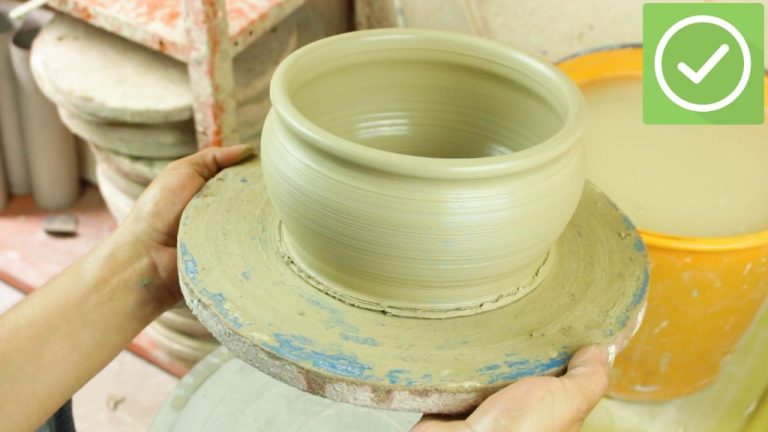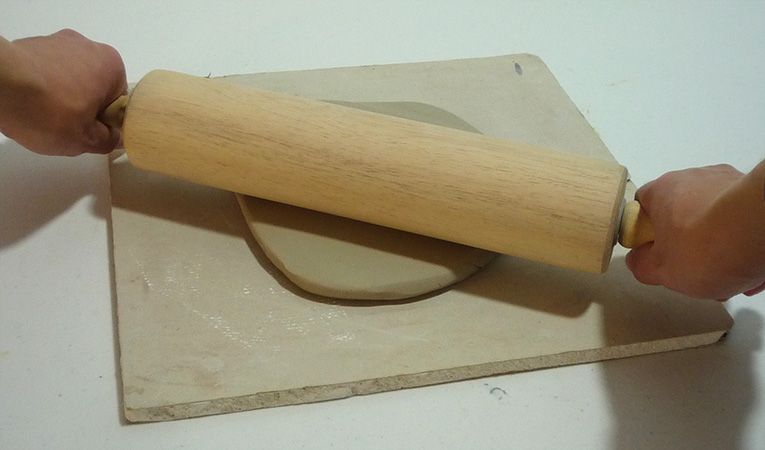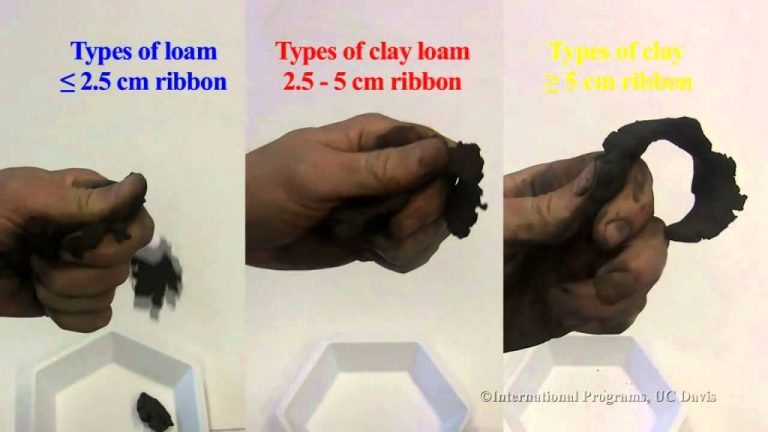Can I Use Air Dry Clay To Make Plant Pots?
Air dry clay, also known as modeling clay, is a non-hardening clay that allows hobbyists and craft makers to create decorative or sculptural pieces without needing a kiln for firing. Unlike potter’s clay that must be fired at high temperatures to harden and set, air dry clay simply dries and cures at room temperature over the course of 1-7 days.
Making your own plant pots and containers from air dry clay has many benefits compared to purchasing mass-produced pots. You can fully customize the shape, size, texture, and decoration. It’s an enjoyable creative outlet and a satisfying hands-on project. With a bit of practice, you can make unique pottery that perfectly suits your plants and decor style.
The general process involves choosing an appropriate clay, preparing your workspace and tools, sculpting the basic pot form, decorating as desired, allowing adequate drying time, sealing the surface, and finally displaying your personalized plant holder.
Types of Air Dry Clay
There are several types of air dry clay that can be used to make plant pots. The most common options include:
Polymer Clay
Polymer clay is made from PVC resin and softeners. It comes in a variety of colors and can be easily blended and shaped. Polymer clay air dries to a hard, plastic-like finish and does not shrink. It’s lightweight and one of the most durable clays for plant pots.
Paper Clay
Paper clay is made by mixing paper pulp with porcelain or earthenware clay. It air dries to a ceramic-like finish and is very lightweight. Paper clay pots are highly absorbent and allow air and moisture to penetrate. The paper makes the clay resistant to cracking and shrinking.
Cold Porcelain
Cold porcelain is made from glue and cornstarch or glue, cornstarch, and white paint. It has a smooth, doughy texture that is easy to sculpt. Cold porcelain air dries to a hard, ceramic-like finish. It’s extremely lightweight but more delicate than other clays.
Modeling Clay
Modeling clays like plastalina are made of vinyl or polyethylene polymers. They don’t harden when air dried and remain malleable. Modeling clays can be used for plant pots but must be fired in a kiln to fully harden. They are softer and may not hold intricate details as well.
Choosing the Right Clay
When selecting an air dry clay for making plant pots, you’ll want to consider the properties of the different types of clay. The main options are:
- Polymer clay – extremely durable and waterproof, best for outdoor use
- Paper clay – made from cellulose so it’s very lightweight, suitable for indoor plants
- Cold porcelain – smooth texture, hardens to a porcelain-like finish, good for decorative indoor pots
- Modeling clay – inexpensive, simple clay that air dries hard, suitable for practicing techniques
For outdoor plant pots, polymer clay is the best choice as it stands up well to the elements and resists cracking. Indoor pots can be made from polymer, paper or cold porcelain clays. Modeling clay is okay for simple shapes and practicing, but it may not hold up long term when used for planters.
Consider the level of detail and finishing as well – polymer clay is great for smoothing, sculpting and adding decorative elements. Paper clay can’t be smoothed too much. Cold porcelain is ideal for delicate detailing. Test out a few types of clay on small projects to see what works best for your purposes.
Tools and Supplies Needed
When working with air dry clay to make plant pots and other sculpted items, having the right tools and supplies on hand will make the process easier and help you achieve better results. Here are some of the basic tools and supplies you’ll need:
Clay sculpting tools – Clay sculpting tools like loop tools, ribbon tools, dotting tools, silicone tipped tools, and needle tools allow you to sculpt fine details, texture surfaces, smooth seams, and create decorative effects in the clay. Have a variety ready for different techniques.
Rolling pin – A rolling pin is essential for rolling out smooth and even slabs of clay to use for constructing planters or other projects. Acrylic or wooden rolling pins work well.
Work surface – Choose a smooth, non-stick work surface for rolling out and sculpting clay. A canvas sheet, wood or marble slab, or acrylic sheet works well. Avoid using porous materials like wood or cardboard which can stick to the clay.
Containers or molds – For shaping pots, bowls, or other vessels, you can use found objects, silicone molds, or improvised containers like jars or food cans to form the basic shape before refining it with clay tools.
Clay Preparation
Properly preparing your air dry clay is an important step before beginning any sculpting project. Air dry clay often arrives quite stiff and dry. To make it malleable enough to sculpt detailed objects like plant pots, you’ll need to knead and condition the clay adequately.
Start by taking a chunk of clay and kneading it vigorously with your hands. Push into the clay forcefully, fold it over itself, and continue kneading until it becomes soft and pliable. If the clay is very stiff, you can also bang and flatten it against your work surface while kneading to help break it down faster.
As you knead, you’ll notice the clay becomes warmer, softer, and more supple. Continue kneading for 5-10 minutes until the clay is smooth, soft, and has an even consistency throughout. Avoid over-kneading though, as this can introduce air bubbles.
Test the clay’s readiness by shaping a portion into a smooth ball. Properly conditioned clay should keep its shape without cracks or creases. If your sculpted ball cracks or breaks apart, continue kneading the clay.
Once the clay is uniformly soft and smooth, it’s ready for sculpting your plant pots and other objects. Make sure to keep unused clay wrapped in plastic or in an airtight container so it doesn’t dry out.
Sculpting Techniques
When making clay pots by hand, there are a few key techniques to smooth, shape, and sculpt the clay:
Hand Sculpting
The most common method is hand sculpting the clay without any molds. This allows for the most creativity and custom shapes. Start by rolling clay into balls or coils, then mold it into the desired form by smoothing, pinching, and blending the clay. Form the bottom and sides first, then gradually build up the walls, smoothing as you go. Aim for an even thickness and refine the shape. Pay attention to symmetry and smooth any fingerprints or cracks. Let the clay firm up slightly between steps.
Using Molds
For simpler pots with uniform shapes, press air dry clay firmly into a mold. Push clay into all crevices, then scrape off any excess. Allow it to set before removing from the mold. You can also use molds just for the base, then hand build up the sides. This gives more flexibility than molding the entire piece.
To smooth clay, use your fingers, a paintbrush dampened with water, or clay sculpting tools. Do not use too much water, as excess moisture can weaken air dry clay. Fill any cracks or holes with small clay balls. Refine shapes by gently pushing, pinching, and smoothing the clay as needed. Let firm up between smoothing steps. Go slow to avoid distortion.
Applying Decorations
One of the best parts of working with air dry clay is decorating your finished pieces. There are endless options for adding color, texture, and personal flair to your plant pots and sculptures.
Stamping is a fun technique that involves pressing premade stamps or found objects into the clay surface to leave an imprint. Things like rubber stamps, cookie cutters, buttons, seashells, and leaves make great stamps. Press firmly and evenly to get a clear impression.
You can also texture the clay by pressing items into it to mimic patterns like wood grain, scales, etc. Use modeling tools, brushes, combs, mesh, or textured fabrics to create grooves, dots, swirls, and more.
Carving or engraving designs after the clay has dried is another option. Use clay sculpting tools, popsicle sticks, or toothpicks to etch patterns or drawings into the surface.
Painting or glazing brings the claywork to life. Acrylic craft paint adds pops of color. You can paint freehand designs, use stencils, or make stamps out of foam. Air dry glazes come in gloss or matte finish to give pottery an authentic clay look.
Seal paint with a top coat like polyurethane or mod podge for longevity. Allow all layers to fully dry between applications for best results.
Drying and Curing
Once your clay pots are sculpted, they need time to dry and cure properly. Air drying can take 1-3 days depending on the size and thickness of your clay pieces. Ensure your pots are dried slowly at room temperature, away from direct sunlight or heat sources. Placing them on a rack allows airflow all around each piece.
Firing or baking your air dry clay pots makes them much harder and more durable. Bake them according to package instructions, usually at 225°F for 30 minutes per 1/4 inch thickness. Check them periodically as they bake. When properly fired, the clay will be hard and have a slightly glossy look. Avoid over-firing clay as it can become brittle. Once fired, clay items are water-resistant but still porous, so use an acrylic sealer for extra protection and durability if needed.
Sealing and Protecting
Sealing your clay pots provides an impervious barrier that helps protect them from the elements and increases their durability. There are a few key benefits to sealing your air dry clay pots:
- Prevents water damage – Sealing makes clay pots waterproof so they don’t absorb moisture or leak. This prevents cracking, swelling, erosion, and mold growth.
- Strengthens surface – Sealants reinforce the clay’s porous surface so it’s less prone to chipping, flaking, or abrasion.
- Locks in paint/glaze – Sealing helps adhere any applied paint or glaze coatings for maximum color vibrancy and prevent wear.
- Improves longevity – A protective seal provides durability against sun, rain, frost and other weathering to extend the pot’s usable lifespan.
The type of sealer you use depends on where the pot will be displayed:
- For indoor use, an acrylic matte spray sealant is recommended. This protects without adding gloss or shine.
- Outdoor pots need a more heavy-duty exterior grade sealer, like a clear enamel, polyurethane or epoxy resin for maximum protection.
Always read the product instructions and apply the sealer in a well-ventilated area. Allow plenty of drying time before use. With a quality sealant, your handcrafted clay pots will last for many years to come.
Displaying Clay Pots
Once your clay pots are fully dried, cured, and sealed, it’s time to decide how to display them. Carefully consider where to place your pots to maximize their visual appeal. Here are some tips:
Outdoors, group a cluster of pots on a patio, front porch, or in your garden. Place them on attractive plant stands at different heights for visual interest. You can also hang clay pots from hooks along a fence or railing. Position them where they will get adequate sunlight and drainage.
Indoors, arrange pots on windowsills, bookshelves, end tables, or other surfaces. A trio or uneven number of pots often looks more organic and visually pleasing. Choose locations near windows to provide your plants with sufficient light.
When selecting plants, consider the pot’s size, shape, and color. miniature succulents can accent pint-sized pots, while larger palms or ornamental grasses pair nicely with bigger vessels. Complement cool-toned blues and greens with lush ferns or ivy. Warm terra cotta pots pop next to hot pink flowers or herbs like mint and basil. Have fun mixing and matching to create your own unique displays!




